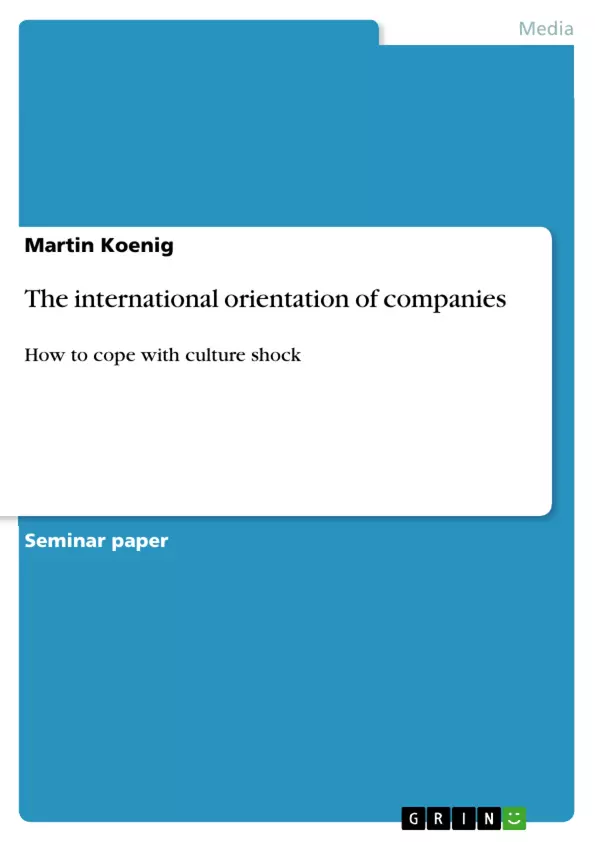In times of progressing globalisation companies are continuing to orientate themselves more and more internationally. Mergers and acquisitions are for instance a possibility to expand their competencies through the co-operation with appropriate partners respectively to take-over another company, in this way ones position in the global competition will be further im-proved. That is why the number of mergers and acquisitions were permanently rising within the last few years. After a slow-down in 2001, the investment in other firms has started again from 2004 so that by 2006 the number of deals rose to almost 39.000.
This evolution of world-wide merger and acquisition deals within the last years is represented in the following figure: [...] Referring to the M&A NOTE of the European Commission, the average value of cross-border deals especially has been consistently higher compared to domestic deals. This can be explained by the fact that about 80% of these activities are concentrated in the EU, the USA and Asia (2007, p.2 et sqq.). That means that in times of incremental internationalisation, trade is in particular taking place between these economic, well-developed areas - as a result multicultural strategic alliances are assumed in order to strengthen their position in global competition. According to a report by the German news agency dpa-AFX, a new record in world-wide transactions was reached in 2007. Compared to the previous year a plus of 1/5th has been realised (Finanznachrichten.de, 20th December 2007).
Table of Contents
- Introduction
- Stylised facts
- Reasons for the International Orientation of Companies
- The relevance of the "culture" factor within strategic alliances
- Definition of culture
- The relationship between culture and behaviour...
- A country's culture versus corporate culture
- Culture differences.
- The problems of cultural differences
- Consequences of cultural differences..
- Culture shock
- Definition of culture
- Intercultural management for problem-solving...........
- The role of cultural mediators.....
- A developmental expatriate model.......
- DaimlerChrysler's experiences of international strategic alliances.
- Conclusion.....
Objectives and Key Themes
This term paper explores the growing international orientation of companies in the context of globalization, focusing on the challenges and opportunities of strategic alliances between organizations from different cultures. The paper aims to understand the role of culture in international business ventures, particularly examining cultural differences and their impact on intercultural management.- The role of culture in global strategic alliances
- The challenges of managing cultural differences
- The impact of culture shock on international partnerships
- Strategies for successful intercultural management
- The lessons learned from the DaimlerChrysler alliance
Chapter Summaries
The introduction sets the stage by discussing the increasing trend of internationalization among companies, citing examples like mergers and acquisitions. This trend is linked to globalization and the pursuit of economies of scale and scope. The chapter also highlights the growing importance of cross-border deals, particularly within the EU, USA, and Asia.
The subsequent chapter delves into the reasons behind this international orientation. It explains how globalization allows companies to expand their businesses, access new markets, and increase their sales through collaboration with local partners. The chapter also introduces the concept of international strategic alliances and the different types of corporate strategies involved, emphasizing the importance of understanding and navigating cultural differences in these ventures.
The following sections explore the concept of culture in greater detail. They define culture, discuss the relationship between culture and behavior, and analyze the differences between national and corporate cultures. The chapter further examines the challenges posed by cultural differences in international business, including communication barriers, differing values, and the potential for conflict. This leads to a discussion of culture shock, its causes, and its effects on individuals and organizations.
The final chapter before the conclusion explores solutions to these challenges. It emphasizes the role of cultural mediators and the importance of developing expatriate management models to address cultural differences. This chapter also touches upon the experiences of DaimlerChrysler, providing an example of the potential pitfalls and challenges of navigating cultural differences within international alliances.
Keywords
This paper explores the intersection of globalization, international business, and intercultural management. Key terms and concepts include: international orientation, strategic alliances, mergers and acquisitions, culture, cultural differences, culture shock, intercultural management, cultural mediators, expatriate management, and globalization.- Arbeit zitieren
- Bachelor Martin Koenig (Autor:in), 2008, The international orientation of companies, München, GRIN Verlag, https://www.grin.com/document/117017



